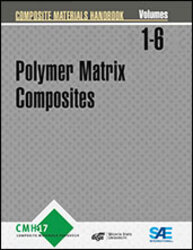
olymer Matrix, Metal Matrix, and Structural Sandwich Composites 6-Volume Set:
- Volume 1: Guidelines for Characterization of Structural Materials
- Volume 2: Materials Properties
- Volume 3: Materials Usage, Design, and Analysis
- Volume 4: Metal Matrix Composites
- Volume 5: Ceramic Matrix Composites
- Volume 6: Structural Sandwich Composites
This 6-volume set includes critical properties of composite materials that meet specific data requirements, as well as guidelines for design, analysis, material selection, manufacturing, quality control, and repair. This newly-updated engineering reference tool, part of the Composite Materials Handbook (CMH-17), also contains the latest test data for polymer matrix composites and metal matrix composites, as well as essential material relating to sandwich composites and ceramic matrix composites used in military and commercial vehicles.
Volume 1 contains guidelines for determining the properties of polymer matrix composite material systems and their constituents, as well as the properties of generic structural elements, including test planning, test matrices, sampling, conditioning, test procedure selection, data reporting, data reduction, statistical analysis, and other related topics. Special attention is given to the statistical treatment and analysis of data. Volume 1 contains guidelines for general development of material characterization data as well as specific requirements for publication of material data in CMH-17.
Volume 2 contains statistically-based data for polymer matrix composites that meets specific CMH-17 population sampling and data documentation requirements, covering material systems of general interest. Selected historical data from previous versions of the handbook that do not meet current data sampling, test methodology, or documentation requirements, but that still are of potential interest to industry are also included in this volume.
Volume 3 provides methodologies and lessons learned for the design, analysis, manufacture, and field support of fiber-reinforced, polymeric-matrix composite structures. It also provides guidance on material and process specifications and procedures for using the data that is presented in Volume 2. The information provided is consistent with the guidance provided in Volume 1, and is an extensive compilation of the current knowledge and experiences of engineers and scientists from industry, government, and academia who are active in composites.
Volume 4 includes properties on metal matrix composite material systems for which data meeting the specific requirements of the handbook are available. In addition, it provides selected guidance on other technical topics related to this class of composites, including material selection, material specification, processing, characterization testing, data reduction, design, analysis, quality control, and repair of typical metal matrix composites.
Volume 5 provides technical guidance and properties on ceramic matrix composite material systems, including material selection, processing, characterization, testing, data reduction, design, analysis, quality control, application, case histories, and lessons learned of typical ceramic matrix composite materials. Volume 5 supersedes MIL-HDBK-17-5 of June 17, 2002.
Volume 6 is an update to the cancelled Military Handbook 23, which was prepared for use in the design of structural sandwich polymer composites, primarily for flight vehicles. The information presented includes test methods, material properties, design and analysis techniques, fabrication methods, quality control and inspection procedures, and repair techniques for sandwich structures in military and commercial vehicles.
The Composite Materials Handbook, referred to by industry groups as CMH-17, is a six-volume engineering reference tool that contains over 1,000 records of the latest test data for polymer matrix, metal matrix, ceramic matrix, and structural sandwich composites. CMH-17 includes critical properties of composite materials that meet specific data requirements as well as guidelines for design, analysis, material selection, manufacturing, quality control, and repair.
The primary purpose of CMH-17 is to standardize engineering methodologies related to testing, data reduction, and reporting of property data for current and emerging composite materials. It is used by engineers worldwide in designing and fabricating products made from composite materials.
Product Details
- Published:
- 07/17/2017
- File Size:
- 1 file , 260 MB